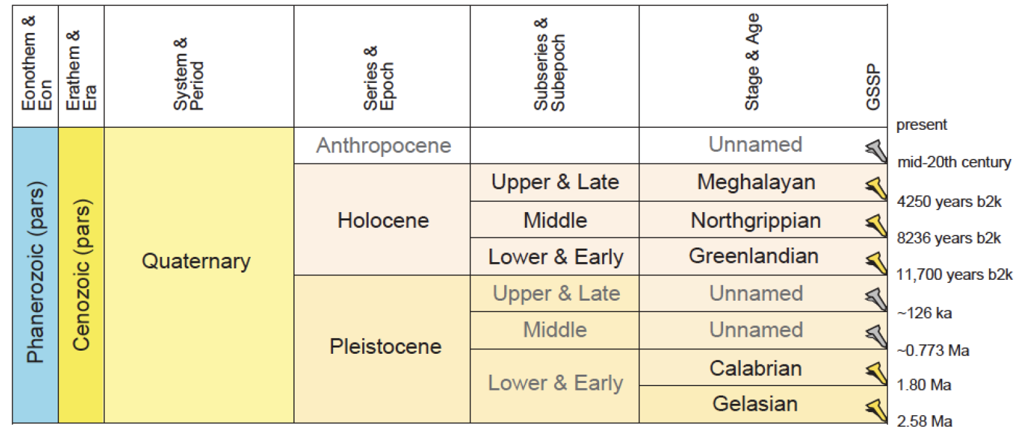Phil Gibbard on the Anthropocene
Listen to the podcast here or wherever you listen to podcasts.
Scroll down for illustrations that support the podcast.
Phil Gibbard is Emeritus Professor of Quaternary Palaeoenvironments at the University of Cambridge and Secretary General of the International Commission on Stratigraphy (ICS). He is a founding member of the Anthropocene Working Group tasked by the ICS to examine the status, hierarchical level, and definition of the Anthropocene as a potential new formal division of the Geological Time Scale. As he explains in the podcast, no consensus on the Anthropocene has been reached, and it remains controversial as to whether there is even a need for such an epoch at all.
Podcast Illustrations
The International Chronostratigraphic Chart, updated as of February 2022. The timescale is updated from time to time by the International Commission on Stratigraphy (ICS). This version differed from the previous version with the addition of a new stage in the Permian, the Artinskian, and the alteration of the numeric ages of the bases of the Fortunian (Cambrian) and the Aptian (Cretaceous) stages. As Phil Gibbard explains in the podcast, while the numeric ages may be updated, the paleontological or climatological definition of the base of each stage is changed very rarely.
The Quaternary time scale as preferred by the ICS Anthropocene Working Group as of February 2022, with the Anthropocene shown at the rank of series/epoch. Black type indicates names officially approved and ratified by the ICS/Executive Committee of the International Union of Geological Sciences (IUGS EC). Names in grey type have yet to be officially sanctioned by ICS/IUGS EC. Golden spike = approved/ratified Global Boundary Stratotype Section and Point (GSSP); grey spike = GSSP awaiting submission or approval.
Geological timeline compared to historical timeline. Scholars have proposed a number of different starting dates for the Anthropocene that correspond to different social and environmental changes evident in the stratigraphic record. Rather than focusing on a single moment of transformation, Phil Gibbard suggests that the Anthropocene denote an event encompassing the whole of human-induced global environmental change.
Gibbard, P.L. et al. (2021), Episodes, Journal of International Geoscience https://doi.org/10.18814/epiiugs/2021/021029; figure adapted from Ellis et al. (2016), Nature, 540, 192
The increasing rates of change in human activity since the beginning of the Industrial Revolution. Significant increases in rates of change occur around the 1950s in each case and illustrate how the second half of the twentieth century has been a period of dramatic and unprecedented change in human history.
Steffen et al. (2011), Phil. Trans. R. Soc. 369, 842
Global scale changes in the Earth system as a result of the dramatic increase in human activity.
Steffen et al. (2011), Phil. Trans. R. Soc. 369, 842
Superposition of the 24 indicators plotted above on a single chart. “The Great Acceleration” has been an important motivator for those advocating the establishment of an official Anthropocene epoch in the geological time scale.
Cumulative vertebrate species extinctions as a percentage of total species. Changes such as these have been considered as indicators of the Anthropocene.
Waters et al. (2016), Science 351, 137
Further Reading
Bonneuil, C. and Fressoz, J. (2017), The Shock of the Anthropocene: The Earth, History and Us, Verso
Ellis, E. (2018), Anthropocene, A Very Short Introduction, Oxford University Press
Gibbard, P. et al. (2021) A Practical Solution: the Anthropocene is a Geological Event, not a Formal Epoch, Episodes, Journal of International Geoscience, https://doi.org/10.18814/epiiugs/2021/021029
ICS Working Group on the ‘Anthropocene,’ http://quaternary.stratigraphy.org/working-groups/anthropocene/
Vince, G. (2015), Adventures in the Anthropocene: A Journey to the Heart of the Planet We Made, Milkweed Editions
Zalasiewicz, J. et al. (2008), Are We Now Living in the Anthropocene, GSA Today 18, 4 doi: 10.1130/GSAT01802A.1
Zalasiewicz, J. (2019), The Anthropocene as a Geological Time Unit, Cambridge University Press








